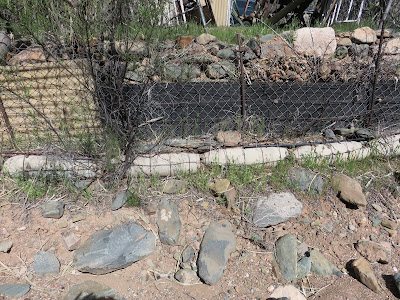Buoyed
by a sunny forecast, five of us gathered at the Safeway parking lot
in Cottonwood at 0500 on 16 July 2011 for a hike on Weatherford
Trail. We drove to Flagstaff and stopped at Denny’s for breakfast.
After breakfast we continued on into
Flagstaff, took US-180 W and followed it about 3.2 miles before
turning right on Schultz Pass Road. We followed Schultz Pass Road
about 5.3 miles to the trailhead parking lot at Schultz Tank. The
turnoff to the parking lot is on the right (south) side of the road.
We arrived at the trailhead at about 0740. A toilet is provided at
the parking lot.
 Donning
our gear we found a sign (right) on
the north side of the lot marking the Weatherford Trailhead. The
trail started out at a gentle slope that varied very little all the
way to our destination at Doyle Saddle. NOTE: A very short distance
up the trail from the parking lot we crossed an old road. On the
north side of this road, a sign says Weatherford Trail while on the
south side it is signed as Schultz Trail. Go figure.
Donning
our gear we found a sign (right) on
the north side of the lot marking the Weatherford Trailhead. The
trail started out at a gentle slope that varied very little all the
way to our destination at Doyle Saddle. NOTE: A very short distance
up the trail from the parking lot we crossed an old road. On the
north side of this road, a sign says Weatherford Trail while on the
south side it is signed as Schultz Trail. Go figure.
About
2 miles (by GPS; 2.4 according to signage) from the parking lot the
Kachina Trail leads in from the left. We continued on up the
mountain on Weatherford, and shortly entered the Peaks Wilderness
area.
We
paused along the way for an occasional rest break and after a couple
of hours for a snack break and a group photograph (below).
We had a long way to go and so didn’t linger for very long. The
trail continued its gentle slope along the old road that, according
to the forest service, originally carried passengers to the peaks via
Model T Fords. Higher up the trail became pretty rocky. Gordon
described it as walking on egg-sized marbles. It is really not too
bad as long as you step carefully, and it does maintain the same
gentle slope all the way.
 |
Left to right: Donna Goodman, Gordon Bice, Dolly Yapp and Betty Wolters
|
Gordon
and I had hiked on ahead a short distance and waited for the rest of
the group to catch up. I took the below photograph as the rest of
the group were arriving.
 |
Left to right: Betty Wolters, Dolly Yapp and Donna Goodman at rest stop
|
We
had, according to my GPS, come 5.8 miles from the trailhead. Hearing
this, Dolly and Betty, declared that as they had only signed up for
an eleven mile round trip hike, this was enough, and they would stop
to eat lunch start back.
Our
hoped for destination was Doyle Saddle where we would be able to look
down into the Inner Basin and up to Humphrey's Peak. So, leaving
Dolly and Betty eating lunch, Gordon, Donna and I pressed on, hiking
another 1.9 miles according to the GPS before reaching Doyle Saddle.
By the time we arrived it was 1220; we were tired and ready to eat.
We could see Humphrey's Peak ahead and Dona and Gordon were able to
pick out where they had been on a hike on Abineau Trail earlier this
year. The inner basin was below us but we really couldn’t see much
of it from the saddle. We ate lunch, I took a nap and shot a few
photographs and we headed back.
 |
From Doyle Saddle - Humphreys Peak (against the sky at upper left)
|
 |
From Doyle Saddle – Looking back toward Flagstaff. Weatherford
Trail is seen to the left in this photo
|
We didn’t note what
time we left Doyle Saddle; however since I did manage to get in a nap
and we spent a bit of time enjoying the view we must have spent most
of an hour there. I will estimate that we started back down about
1315.
The far-off views all
along Weatherford Trail were spectacular now that we were facing down
the mountain and we were torn between looking far away and watching
our step on the loose, round pebbly surface of the old tourist road
the trail follows.
We stopped often just to
look without the bother of switching our view to look where we were
stepping. The below photograph, with a view of Flagstaff and beyond
from just below Doyle Saddle, was taken during one of these stops.
 |
View looking out over Flagstaff – Taken from Weatherford Trail just
below Doyle Saddle
|
We
arrived back at the trailhead at 1645 to find Betty and Dolly waiting
for us. According to the sign at the trailhead, the distance to
Doyle Saddle is 6 miles and our round trip hike would have been 12
miles. However, the one-way distance as measured by my GPS was 7.8
miles, making it 15.6 miles round trip. I don’t know which
measurement is more accurate; however, my feet were telling me to go
with the GPS reading. The highest elevation was 10877 feet and the
total ascent was 3138 feet.
The
GPS elevation readings were 8047 feet at the trailhead and 10877 at
Doyle Saddle, an elevation difference of 8030 feet.
Our
track is shown on the included map (below).


























